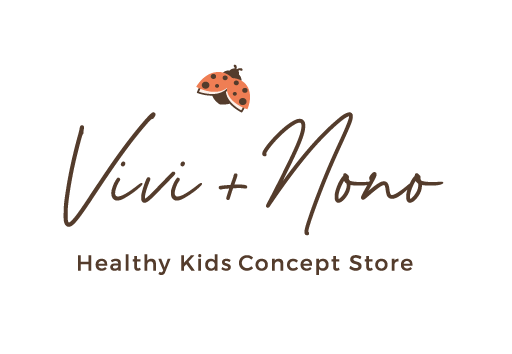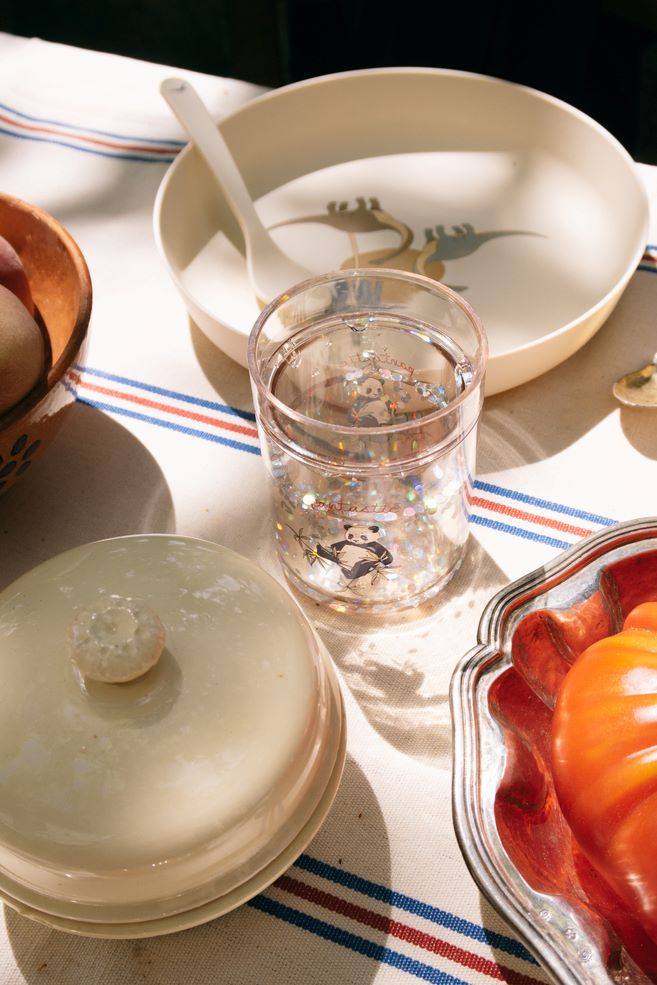Have you ever wondered if it makes a difference whether you serve your child's pasta on a plastic, silicone or ceramic plate? Or which bowl you feed your baby puree from?
The short answer is: Yes, it does matter! Why? We'll explain it to you in this blog post.

You can buy children's tableware in a wide variety of materials. There are big differences and many advantages and disadvantages.
Let's take a closer look at the different materials and their advantages and disadvantages. Maybe this will make it easier for you to choose the tableware for your child.
Let's start with:
Plastic is made from fossil raw materials (crude oil or natural gas) and additives. This creates several problems for plastic children's tableware:

- Additives include plasticizers (phthalates) or bisphenol A and others. Many of these additives can be harmful in that they can be carcinogenic, disrupt protein functions or affect the hormonal balance if they dissolve out of the plastic and are absorbed by the body.
- Natural gas and petroleum are fossil raw materials and therefore not sustainable. Production from fossil raw materials poses an environmental problem.
- Plastic is extremely durable and takes hundreds of years to decompose. The released microplastics pollute our waters and oceans.
Of course, plastic also has advantages. It is very light and break-proof, making it ideal for children's tableware. But let's look at other materials. Perhaps we can find others whose properties make them suitable for children's tableware without putting such a strain on the environment and health.
A distinction is made here as to whether a plate is made from biologically based materials or whether it is biodegradable .

Made from biologically based raw materials:
This tableware is also made of plastic, but it is made of a plastic that is not made from fossil raw materials (i.e. not from crude oil or natural gas) but from renewable raw materials. For example, from cellulose, corn, beets or cane sugar. This makes it more sustainable to produce than a normal plastic plate. Otherwise, it is exactly the same as a non-bioplastic plate. Neither more biodegradable nor better for your health.
Made from biodegradable materials:
This bioplastic is biodegradable under certain conditions (but only in industrial composting plants). This plastic can be made from fossil or biologically based raw materials.
Melamine tableware is made from melamine and formaldehyde.

Caution is advised here! If a melamine plate is heated to over 70 degrees, melamine and formaldehyde can be released.
Melamine and formaldehyde are irritating, toxic and carcinogenic in animal experiments. (Animal experiments have shown that melamine is particularly toxic to the bladder, while formaldehyde is an irritant to the skin and mucous membranes. In addition, formaldehyde can cause cancer in the nasopharynx if inhaled).
In further studies, melamine levels were measured in children and adults. According to the BfR, the melamine levels did not show any health risk for adults. However, small children who very frequently eat hot food from melamine dishes and especially from "bamboo dishes" can ingest up to three times the tolerated daily dose.
Should we throw away melamine plates now?
If you have melamine dishes at home, you should only prepare cold food and drinks in them. It should not be used for hot, acidic or fatty foods and drinks. Under no circumstances should it be used in the microwave.
We recommend not buying it at all, and if you already have some at home, it's best to throw it out. It will definitely find a new use in the play kitchen.

This tableware is in no way better than pure melamine tableware. On the contrary, bamboo/melamine tableware has been found to release significantly higher amounts of melamine and formaldehyde on average. It is also not more biodegradable.
There are also dishes made of pure bamboo. The disadvantage here is that these dishes should not be cleaned in the dishwasher. They also need special care. If they are not cared for properly, cracks can form in which bacteria can accumulate.
Also, please note that it cannot be used in the microwave.
Silicone tableware is a special type of plastic/synthetic tableware. Silicone is not made from fossil raw materials, but from silicon, chlorine and methane. Since silicon is mainly extracted from sand, it is a mixture of plastic and natural product. Silicone has the great advantage that it is flexible without plasticizers. Unfortunately, like plastic, silicone is difficult to degrade.

Stainless steel tableware is made of steel. Steel is mostly made of iron (mixed with chromium, molybdenum, nickel and titanium, for example). Stainless steel tableware has many advantages. No plasticizers or other harmful substances dissolve in stainless steel. It is tasteless and odorless. It is also light, robust and recyclable. This makes it an ideal material for children's tableware.

The big advantage of glass is that it doesn't release any harmful substances, it's tasteless and odorless, and it's recyclable. We all know the big disadvantage. If the plate falls, there are broken pieces.
Ceramics are made from various substances such as sand and clay, quartz, granite and metal oxides. These are fired at high temperatures to create ceramics.

earthenware:
Stoneware is fired at lower temperatures and therefore does not vitrify/sinter. For this reason, stoneware is not waterproof and requires a glaze to become waterproof.
The production of earthenware is cheaper than that of stoneware and porcelain. Therefore, earthenware is the cheapest representative in this group.
These glazes can be contaminated with heavy metals. However, glazes made from glass are harmless.
Stoneware:
Stoneware is fired at very high temperatures. This causes it to vitrify/sinter and the stoneware becomes waterproof. A glaze is therefore not required. (But it can be used).
China:
Porcelain is also fired at very high temperatures and is therefore waterproof.
Our conclusion:
Now, what is the moral of the story?
Of course, you can now decide for yourself which material you think is suitable for children's tableware and which advantages and disadvantages outweigh each other for you.
We would also like to make a personal recommendation here:

Our favorites are ceramic, glass and stainless steel dishes.
We recommend switching to ceramic, stainless steel or glass tableware as early as possible. You will be amazed at how quickly children learn to handle these materials carefully and respectfully.
For the first baby food (i.e. when your baby is not yet eating independently), ceramic and glass are ideal for preparing and feeding your little one.
As soon as your baby starts eating independently, these materials are of course not ideal. It is completely normal that plates and cups will fall to the floor again and again, both intentionally and inadvertently, during this phase. Robust dishes made of silicone or stainless steel are of course more suitable. Plates with a suction cup that can be attached to the table are particularly recommended during this phase.
However, after a few months it is possible to switch back to ceramic dishes.
When exactly this point is, of course, varies. Every child is different. There are more cautious and more fidgety children at the table. The phase of “testing gravity” also lasts a different amount of time for each child.
For every child, one or two ceramic plates will probably not survive this change (which is why it is worth offering the child very cheap plates at the beginning). But you will be amazed at how quickly your child learns to handle ceramic plates more carefully than plastic plates.
It understands very early on that the consequences of a ceramic plate falling to the floor are not the same as those of a plastic plate. Your reaction is different, the noise is completely different and the consequence of that is also different: the plate is not put back on the table and you can just carry on eating.
Children want to imitate their role models. Give them trust. It will make them proud and self-confident and teach them to take responsibility.
In this sense, “en Guete”


